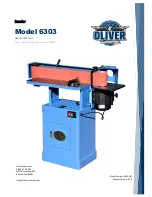
GENERAL & SPECIFIC SAFETY
INSTRUCTIONS FOR YOUR DISC SANDER
SPECIFIC SAFETY INSTRUCTIONS FOR DISC SANDER
Safety is a combination of common sense, staying alert and knowing
how your disc sander works. Read this manual to understand this
sander.
bEFORE USING ThE SANDER
wARNING:
To avoid mistakes that could cause serious, permanent in-
jury, do not plug sander in until the following is understood.
• Assembly and alignment.
• Learn the use and function of the ON-OFF switch, work table and work
table tilt lock knobs.
• Review and understanding of all safety instructions and operating pro-
cedures in this manual.
• Review of the maintenance methods for this sander.
whEN INSTALLING OR MOVING ThE SANDER
AVOID DANGEROUS ENVIRONMENT
. Use the sander in a dry, indoor
place protected from rain. Keep work area well lighted. Place the sander
so neither the user nor bystander are forced to stand in line with the
abrasive belt or disc.
To avoid injury from unexpected sander movement:
• Always unplug the sander before moving it.
• Put the sander on a firm level surface where there is plenty of room
for handing and properly supporting the workpiece.
• Support the sander so it does not rock.
•
NEVER STAND ON TOOL
. Serious injury could occur if the tool tips.
Do not store anything above or near the tool where anyone might
stand on the tool to reach them.
bEFORE EACh USE: Inspect your sander.
DISCONNECT THE SANDER. To avoid injury from accidental starting,
unplug the sander, turn the switch off and remove the switch key before
changing the setup, sanding disc or adjusting anything.
CHECK DAMAGED PARTS, Check for:
• alignment of moving parts
• binding of moving parts
• broken parts
• worn or damaged electric cords,
• stable mounting , and
• any other conditions that may affect the way the sander works.
1. KNOw YOUR TOOL
Read and understand the owners manual and labels affixed to the
tool. Learn its application and limitations as well as its specific po-
tential hazards.
2. GROUND ThE TOOL.
This tool is equipped with an approved 3-conductor cord and a
3-prong grounding type plug to fit the proper grounding type re-
ceptacle. The green conductor in the cord is the grounding wire.
NEVER
connect the green wire to a live terminal.
3. KEEP GUARDS IN PLACE.
Keep in good working order, properly adjusted and aligned.
4. REMOVE ADJUSTING KEYS AND wRENChES.
Form habit of checking to see that keys and adjusting wrenches
are removed from tool before turning it on.
5. KEEP wORK AREA CLEAN.
Cluttered areas and benches invite accidents. Make sure the floor
is clean and not slippery due to wax and sawdust build-up.
6. AVOID DANGEROUS ENVIRONMENT.
Don’t use power tools in damp or wet locations or expose them to
rain. Keep work area well lit and provide adequate surrounding
work space.
7. KEEP ChILDREN AwAY.
All visitors should be kept a safe distance from work area.
8. MAKE wORKShOP ChILD-PROOF.
-with padlocks, master switches or by removing starter keys.
9. USE PROPER SPEED.
A tool will do a better and safer job when operated at the proper
speed.
10. USE RIGhT TOOL.
Don’t force the tool or the attachment to do a job for which it was
not designed.
11. wEAR PROPER APPAREL.
Do not wear loose clothing, gloves, neckties or jewelry (rings,
watch) because they could get caught in moving parts. Non-slip
footwear is recommended. Wear protective hair covering to
contain long hair. Roll up long sleeves above the elbows.
12. ALwAYS wEAR SAFETY GLASSES.
Always wear safety glasses (ANSI Z87.1). Everyday eye-glasses
only have impact resistant lenses, thet are
NOT
safety glasses.
Also use a face or dust mask if sanding operation is dusty.
13. DON’T OVERREACh.
Keep proper footing and balance at all times.
14. MAINTAIN TOOL wITh CARE.
Keep tools sharp and clean for best and safest performance. Fol-
low instructions for lubricating and changing accessories.
15. DISCONNECT TOOLS.
Before servicing, when changing accessories or attachments.
16. AVOID ACCIDENTAL STARTING.
Make sure the swich is in the ‘’OFF’’ position before plugging in.
17. USE RECOMMENDED ACCESSORIES.
Consult the manual for recommended accessories. Follow the in-
structions that accompany the accessories. The use of improper
accessories may cause hazards.
18. NEVER STAND ON TOOL.
Serious injury could occur if the tool tips over. Do not store materials
such that it is necessary to stand on the tool to reach them.
19. ChECK DAMAGED PARTS.
Before further use of the tool, a guard or other parts that are dam-
aged should be carefully checked to ensure that they will operate
properly and perform their intended function. Check for alignment
of moving parts, breakage of parts, mounting, and any other con-
ditions that may affect its operation. A guard or other parts that are
damaged should be properly repaired or replaced.
20. NEVER LEAVE MAChINE RUNNING UNATTENDED.
Turn power ‘’OFF’’. Don’t leave any tool running until it comes to a
complete stop.


























